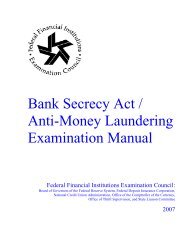A Guide to HMDA Reporting - ffiec
A Guide to HMDA Reporting - ffiec
A Guide to HMDA Reporting - ffiec
You also want an ePaper? Increase the reach of your titles
YUMPU automatically turns print PDFs into web optimized ePapers that Google loves.
Introduction Purposes of <strong>HMDA</strong><br />
The Home Mortgage Disclosure Act,<br />
enacted by Congress in 1975 and<br />
made permanent in 1988, requires<br />
deposi<strong>to</strong>ry and nondeposi<strong>to</strong>ry lenders<br />
<strong>to</strong> collect and publicly disclose information<br />
about housing-related loans<br />
and applications for such loans,<br />
including several applicant/borrower<br />
characteristics. <strong>HMDA</strong> is implemented<br />
by the Federal Reserve Board’s<br />
Regulation C (12 CFR Part 203) and a<br />
staff commentary (12 CFR Part 203,<br />
Supp. I).<br />
The housing-loan data that lenders<br />
must disclose under <strong>HMDA</strong>:<br />
¢ show whether financial institutions<br />
are serving the housing credit<br />
needs of their neighborhoods and<br />
communities;<br />
¢ assist in directing government officials<br />
and private inves<strong>to</strong>rs <strong>to</strong> areas<br />
that may need investment; and<br />
¢ help identify possible discrimina<strong>to</strong>ry<br />
lending patterns and assist regula<strong>to</strong>ry<br />
agencies in enforcing compliance<br />
with antidiscrimination statutes.<br />
<strong>HMDA</strong> does not prohibit any activity, nor<br />
is it intended <strong>to</strong> encourage unsound<br />
lending practices or the allocation of<br />
credit.<br />
Data Collection, <strong>Reporting</strong>,<br />
and Disclosure in a Nutshell<br />
As implemented by Regulation C, <strong>HMDA</strong><br />
requires covered deposi<strong>to</strong>ry and nondeposi<strong>to</strong>ry<br />
institutions <strong>to</strong> collect and<br />
publicly disclose information about<br />
applications for, originations of, and<br />
purchases of home purchase loans,<br />
home improvement loans, and refinancings.<br />
Whether an institution is covered<br />
depends generally on its asset size, its<br />
location, and whether it is in the business<br />
of residential mortgage lending.<br />
The regulation’s coverage criteria are<br />
illustrated in diagrams in the next chapter,<br />
Who Must Report.<br />
There are three categories of loans that<br />
must be reported: home purchase,<br />
home improvement, and refinancing.<br />
Each has a specific definition, which<br />
may vary from your institution’s use of<br />
the term. You will find the definitions in<br />
the chapter Data <strong>Reporting</strong> in General.<br />
There you will also find a list of types of<br />
transactions that are not reportable<br />
under <strong>HMDA</strong>.<br />
Every loan application, origination, and<br />
purchase that falls in<strong>to</strong> one or more of<br />
the three categories must be reported.<br />
With some exceptions, for each transaction<br />
the lender reports data about:<br />
¢ the loan, such as its type and<br />
amount;<br />
¢ the property, such as its location<br />
and type;<br />
¢ the disposition of the application,<br />
such as whether it was denied or<br />
resulted in an origination; and<br />
¢ the applicant (namely, ethnicity,<br />
race, sex, and income).<br />
That information must be recorded on a<br />
form known as the <strong>HMDA</strong> loan/application<br />
register (variously known as the<br />
<strong>HMDA</strong>-LAR, the LAR, or the register).<br />
A summary of the instructions for completing<br />
the LAR appears in the chapter<br />
Completing the LAR Step by Step.<br />
Additional information essential <strong>to</strong><br />
reporting property location appears in<br />
the chapter Sources of Geographic<br />
Information (Geocoding Tools).<br />
1
















